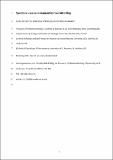Files in this item
Sperm is a sexual ornament in rose bitterling
Item metadata
| dc.contributor.author | Smith, Carl Hendrik | |
| dc.contributor.author | Spence, Rowena Grace Alison | |
| dc.contributor.author | Reichard, Martin | |
| dc.date.accessioned | 2019-08-16T23:42:32Z | |
| dc.date.available | 2019-08-16T23:42:32Z | |
| dc.date.issued | 2018-08-17 | |
| dc.identifier | 254844818 | |
| dc.identifier | b0ef9462-1ea8-4bfd-b507-4f122cadb518 | |
| dc.identifier | 85052393158 | |
| dc.identifier | 000451783400001 | |
| dc.identifier.citation | Smith , C H , Spence , R G A & Reichard , M 2018 , ' Sperm is a sexual ornament in rose bitterling ' , Journal of Evolutionary Biology , vol. Early View . https://doi.org/10.1111/jeb.13357 | en |
| dc.identifier.issn | 1010-061X | |
| dc.identifier.other | ORCID: /0000-0003-3285-0379/work/47928968 | |
| dc.identifier.uri | https://hdl.handle.net/10023/18328 | |
| dc.description.abstract | In many taxa, odour cues mediate mating decisions. A key question is what these odours comprise, where they are produced, and what they signal. Using rose bitterling, fish that spawn in the gills of freshwater mussels, we investigated the role of sperm cues on female oviposition decisions using individuals of known MHC genotype. Male bitterling frequently released sperm prior to female oviposition and females responded with an increased probability of oviposition and released a greater number of eggs, particularly if males had a dissimilar MHC genotype. These mating preferences by females were shown to be adaptive, with MHC dissimilarity of males and females correlated positively with embryo survival. These results support a role for indirect benefits to rose bitterling mate choice and we propose that sperm acts as a releaser pheromone in bitterling, functioning as a sexual ornament signalling male quality as a mate. | |
| dc.format.extent | 13 | |
| dc.format.extent | 496721 | |
| dc.language.iso | eng | |
| dc.relation.ispartof | Journal of Evolutionary Biology | en |
| dc.subject | Ejaculate | en |
| dc.subject | Mate choice | en |
| dc.subject | Pheromone | en |
| dc.subject | Sexual selection | en |
| dc.subject | Spermatozoa | en |
| dc.subject | QH301 Biology | en |
| dc.subject | DAS | en |
| dc.subject.lcc | QH301 | en |
| dc.title | Sperm is a sexual ornament in rose bitterling | en |
| dc.type | Journal article | en |
| dc.contributor.institution | University of St Andrews. School of Biology | en |
| dc.contributor.institution | University of St Andrews. Marine Alliance for Science & Technology Scotland | en |
| dc.contributor.institution | University of St Andrews. Scottish Oceans Institute | en |
| dc.contributor.institution | University of St Andrews. School of Psychology and Neuroscience | en |
| dc.identifier.doi | 10.1111/jeb.13357 | |
| dc.description.status | Peer reviewed | en |
| dc.date.embargoedUntil | 2019-08-17 |
This item appears in the following Collection(s)
Items in the St Andrews Research Repository are protected by copyright, with all rights reserved, unless otherwise indicated.

